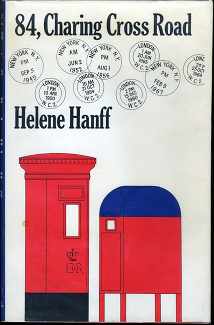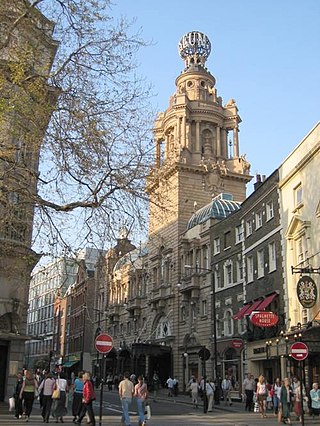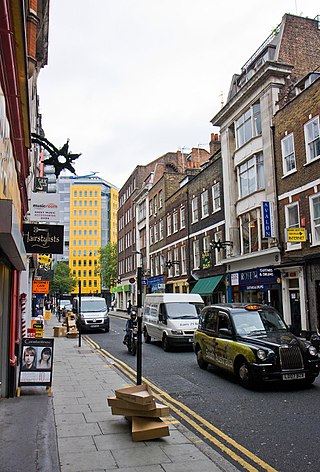
Cecil Court is a pedestrian street with Victorian shop-frontages in Westminster, England, linking Charing Cross Road and St Martin's Lane. Since the 1930s, it has been known as the new Booksellers' Row.

Cecil Court is a pedestrian street with Victorian shop-frontages in Westminster, England, linking Charing Cross Road and St Martin's Lane. Since the 1930s, it has been known as the new Booksellers' Row.
One of the older thoroughfares in Covent Garden, Cecil Court dates to the end of the 17th century and earlier maps clearly identify a hedgerow running down the street's course. A tradesman's route at its inception, it much later acquired the nickname "Flicker Alley" from the concentration of early film companies in the Court. It is now known as home to about a dozen antiquarian and second-hand independent bookshops, including specialists in modern first editions, collectible children's books, early printing, rare maps and atlases, antique prints, music, and esoterica, as well as art galleries, an antiques shop, shops specialising in antique silver, militaria, numismatics, porcelain, jewellery and art deco.
The street is sometimes nicknamed "Booksellers' Row"; [1] an earlier "Booksellers' Row" existed at Holywell Street, London, demolished circa 1900.
It has been suggested that the street was named after Robert Cecil, 1st Earl of Salisbury, the 1st Earl of Salisbury, an important courtier to Queen Elizabeth I and renowned as a trailblazing spymaster. However, it seems to be one of a number of nearby streets and places that have been named after the land-owning family including Cranbourn Street and The Salisbury pub on St Martin's Lane.
A substantial part of Cecil Court was razed to the ground in 1735, almost certainly arson on the part of a tenant, Mrs. Colloway, who was running a brandy shop/brothel in the street at the time: she purchased kindling, emptied her brandy barrels, over-insured her stock and made certain that she was drinking nearby with friends at the time the fire took hold. However, she was acquitted.

The street rose from the ashes to become the temporary home of an eight-year-old Wolfgang Amadeus Mozart while he was touring Europe in 1764. For almost four months, the Mozart family lodged with barber John Couzin. Tickets for Mozart's first London concerts were sold from Couzin's shop and, while living there, the young Mozart performed twice for King George III and was tested for his musical ability by Dr. Charles Burney. [2] According to some modern authorities, Mozart composed his first symphony while a resident of Cecil Court. [3] In September 2011, the Cecil Court Traders' Association installed a plaque commemorating Mozart's relatively brief, but significant, period of residence in the street. The plaque sits at Number 9 Cecil Court, which—contrary to earlier assumptions placing the Mozart lodgings at Number 19 [4] —has been confirmed as the site of John Couzin's barber shop. Cecil Court bookseller Tim Bryars consulted original source material, including the parish rate books of the time and a number of antique maps, to establish where in the street the young Mozart lived. [5]
The plaque was unveiled by actor and author Simon Callow, who created the role of Amadeus on stage. The ceremony was accompanied with music from members of Opera Holland Park and the City of London Sinfonia including pieces from Mozart's London Sketchbook which it is quite possible might have been composed in Cecil Court.

Cecil Court was an important focus of the early British cinema industry, with over forty entries to be found in the database of the study of the film business in London, 1894–1914, organised by the AHRB Centre for British Film and Television Studies, searchable online as part of the London Project. [6] Arising from this, the street is sometimes called "Flicker Alley". The first film-related company arrived in Cecil Court in 1897, a year after the first demonstration of moving pictures in the United Kingdom and a decade before London's first purpose-built cinema opened its doors. The street was renowned as the place to buy or hire a film in Edwardian London, associated with many of the most important film-makers and distributors in early cinema. Home-grown pioneers including Cecil Hepworth and James Williamson had their offices there; but so did international companies including Gaumont, Nordisk, and American Vitagraph.
Cecil Court's importance has been frequently cited by filmmakers and historians. It was the location for the UK's first concentration of film-related businesses, which were almost exclusively new companies, bringing new skills to the industry and sharing products, resources, information and clientele (for example, dividing the costs of transporting the film reels themselves, and offering joint screenings to the showmen who hired them). The earlier businesses tended to be "one-stop shops"—filmmakers and dealers in films and equipment. From 1907, this new wave of businesses were often more specialised: dealers in the import and distribution of foreign films, or specialists in film rental or equipment alone. One business specialised in cinema confectionery, and for a time the trade periodical The Bioscope was published from number 8. [7]
The US-based Flicker Alley home video and film distribution company, founded in 2002, is named as a homage to Cecil Court's history. [8]

In December 2012, Simon Callow returned to Cecil Court to unveil a plaque celebrating "Flicker Alley" and the street's significant role in the British film industry.
The street is still owned by the Cecil family and the buildings one can see today were laid out c. 1894 during the tenure of long-serving British Prime Minister Robert Gascoyne-Cecil, 3rd Marquess of Salisbury. Today, Cecil Court is part of the Jubilee Walkway (opened in 1977 as the Silver Jubilee Walkway). The nearest Underground station is Leicester Square.
The street is sometimes used as a location by film companies. [9] [10] On film, Cecil Court bookshops feature in Victim (1961), The Human Factor (1979), 84 Charing Cross Road (1987), Miss Potter (2006) and Last Christmas (2019). Bookshops set in Cecil Court feature briefly in a number of novels, such as Ben Aaronovitch's Broken Homes .
Cecil Court is one of several locations which has been touted as an inspiration for Diagon Alley in the Harry Potter franchise.[ citation needed ] When asked directly in 2020, author J. K. Rowling denied that there is any connection: "I'm laughing here... I had no idea how many streets were claiming to be the inspiration for Diagon Alley... [it was not] based on any real place". [11]

Soho is an area of the City of Westminster in the West End of London. Originally a fashionable district for the aristocracy, it has been one of the main entertainment districts in the capital since the 19th century.

Charing Cross Road is a street in central London running immediately north of St Martin-in-the-Fields to St Giles Circus, which then merges into Tottenham Court Road. It leads from the north in the direction of Charing Cross at the south side of Trafalgar Square. It connects via St Martin's Place and the motorised east side of the square.

An alley or alleyway is a narrow lane, path, or passageway, often reserved for pedestrians, which usually runs between, behind, or within buildings in the older parts of towns and cities. It is also a rear access or service road, or a path, walk, or avenue in a park or garden.

Wardour Street is a street in Soho, City of Westminster, London. It is a one-way street that runs north from Leicester Square, through Chinatown, across Shaftesbury Avenue to Oxford Street. Throughout the 20th century the West End street became a centre for the British film industry and the popular music scene.

Chinatown is an ethnic enclave in the City of Westminster, London, bordering Soho to its north and west, Theatreland to the south and east. The enclave currently occupies the area in and around Gerrard Street. It contains a number of Chinese restaurants, bakeries, supermarkets, souvenir shops, and other Chinese-run businesses. The first Chinatown was located in Limehouse in the East End.

W & G Foyle Ltd. is a bookseller with a chain of seven stores in England. It is best known for its flagship store in Charing Cross Road, London. Foyles was once listed in the Guinness Book of Records as the world's largest bookshop in terms of shelf length, at 30 miles (48 km), and of number of titles on display. It was bought by Waterstones in 2018.
Waterstones Booksellers Limited, trading as Waterstones, is a British book retailer that operates 311 shops, mainly in the United Kingdom and also other nearby countries. As of February 2014, it employs around 3,500 staff in the UK and Europe. An average-sized Waterstones shop sells a range of approximately 30,000 individual books, as well as stationery and other related products.
J. K. Rowling's Harry Potter universe contains numerous settings for the events in her fantasy novels. These locations are categorised as a dwelling, school, shopping district, or government-affiliated locale.
Blackwell UK, also known as Blackwell's and Blackwell Group, is a British academic book retailer and library supply service owned by Waterstones. It was founded in 1879 by Benjamin Henry Blackwell, after whom the chain is named, on Broad Street, Oxford. The brand now has a chain of 18 shops, and an accounts and library supply service. It employs around 1000 staff in its divisions.

84, Charing Cross Road is a 1970 book by Helene Hanff, later made into a stage play, television play, and film, about the twenty-year correspondence between the author and Frank Doel, chief buyer of Marks & Co antiquarian booksellers, located at the eponymous address in London, England.

St Martin's Lane is a street in the City of Westminster, which runs from the church of St Martin-in-the-Fields, after which it is named, near Trafalgar Square northwards to Long Acre. At its northern end, it becomes Monmouth Street. St Martin's Lane and Monmouth Street together form the B404.

Helene Hanff was an American writer born in Philadelphia, Pennsylvania. She is best known as the author of the book 84, Charing Cross Road, which became the basis for a stage play, television play, and film of the same name.

Dillons was a British bookseller founded in 1936, named after its founder and owner Una Dillon. Originally based in Bloomsbury in London, the company expanded under subsequent owners Pentos in the 1980s into a bookselling chain across the United Kingdom. In 1995 Pentos went into receivership and sold Dillons to Thorn EMI, which immediately closed 40 of the 140 Dillons bookstore locations. Of the remaining 100 stores, most kept the name Dillons, while the remainder were Hatchards and Hodges Figgis. Within Thorn EMI, Dillons was placed in the HMV Group, which had been a division of Thorn EMI since 1986. EMI demerged from Thorn in August 1996, and Dillons-HMV remained an EMI holding. Dillons was subsumed under rival chain Waterstones' branding in 1999, at which point the brand ceased to exist.

Denmark Street is a street on the edge of London's West End running from Charing Cross Road to St Giles High Street. It is near St Giles in the Fields Church and Tottenham Court Road station. The street was developed in the late 17th century and named after Prince George of Denmark. Since the 1950s it has been associated with British popular music, first via publishers and later by recording studios and music shops. A blue plaque was unveiled in 2014 commemorating the street's importance to the music industry.
Frank Percy Doel was a British antiquarian bookseller for Marks & Co in London who achieved posthumous fame as the recipient of a series of humorous letters from American author Helene Hanff, to which he scrupulously and, at first, very formally replied. The shop where he worked was at 84 Charing Cross Road, the title of a bestselling 1970 book written by Hanff which became a cult classic, a 1981 stage play, and a 1987 film starring Anthony Hopkins as Doel and Anne Bancroft as Hanff.
Clive Farahar is a British dealer and expert on books and manuscripts. He is best known as an expert on the BBC's Antiques Roadshow, which he joined in 1986.

20 Frith Street is a building in the Soho district of London. It is located on the east side of Frith Street, close to the junction with Old Compton Street. The building which currently occupies the site of 20 Frith Street was built in 1858 by William Cooze to replace a house which dated from c1725, which itself may have replaced an even earlier building.

The book trade in the United Kingdom has its roots as far back as the 14th century, however the emergence of internet booksellers such as Amazon partnered with the introduction of the e-Book has drastically altered the scope of the industry. Book retailers such as the Borders Group have failed to adjust to these changes, thus there has been a steep decline in the number of operating traditional and independent bookshops. However, still heavily influential on the trade globally, British publishers such as Penguin Books and Pearson remain dominant players within the industry and continue to publish titles globally.
This is a list of the etymology of street names in the London district of Covent Garden. Covent Garden has no formally defined boundaries – those utilised here are: Shaftesbury Avenue to the north-west, New Oxford Street and High Holborn to the north, Kingsway and the western half of the Aldwych semi-circle to the east, Strand to the south and Charing Cross Road to the west.

Housmans is a bookshop in London, England, and is one of the longest-running radical bookshops in the United Kingdom. The shop was founded by a collective of pacifists in 1945 and has been based in Kings Cross, since 1959. Various grassroots organisations have operated from its address, including the Gay Liberation Front, the Campaign for Nuclear Disarmament, and London Greenpeace. Housmans shares its building with its sister organisation Peace News.